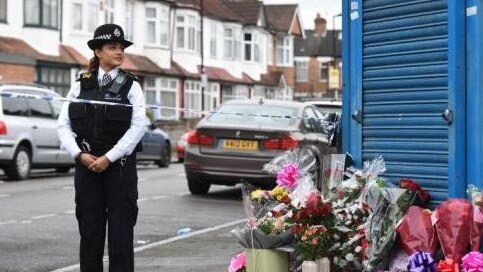Lessons in race, absent police and runaway crime

London’s crime wave continues — and there is much we can learn from it and the problems police are facing in Britain. Of course all Western police forces are distracted by the need to prevent terror crimes, but too many of London’s police are desk-bound and process-driven while their bosses fear a civil libertarian backlash if they crack down on ethnic-based crime. As in Australia, England’s judges and magistrates are reluctant to deliver custodial sentences, even for repeat offenders.
I have been in London for the annual International Fire and Security Exhibition and Conference where the capital’s levels of violent crime was a talking point.
About 200,000 Australians live in London and a million of us visit each year. Stats aren’t kept on them as victims of crime and in any case many are dual nationals.
The exception is for terrorist incidents where those killed and injured are always identified by nationality. Last year, there were three terror attacks in London killing 13 people and injuring about 100. Two Australians died and three others were injured.
Despite some alarmist media reporting, the likelihood of becoming a homicide victim in London has been fairly constant for a decade. Last year, 130 homicides were recorded in London, including the 13 terrorist victims — there had been 156 the year before. By the end of last month there had been another 80.
Most occur in working-class areas, with Lambeth, Southwark, Newham, Hackney and Brent being the top five boroughs for homicides. Kensington and Chelsea borough — which contains Earls Court, favoured by generations of Australians — ranks 30th out of 32 boroughs for homicides.
What has undoubtedly increased is the level of violent crime other than homicides. The Financial Times recently reported that gun crime had increased by 42 per cent, knife crime 24 per cent, theft from the person almost 12 per cent and car theft 26 per cent. The two London boroughs with the highest rate of gun and knife crime were Southwark and Lambeth.
So far this year there have been 1500 stabbings and about 50 stabbing deaths. I was told by police that most of the shootings and stabbings in London are “black-on-black”, and are gang and drug-related. Most gang members are aged 10 to 27. Gang leaders are usually sophisticated criminals who exploit the younger members to control local areas, mainly to traffic drugs. Sub-teens can be used for violent attacks and are unlikely to be punished.
A just-released year-long London South Bank University study focused on a Waltham Forest gang calling itself the Mali Boys. A 40-strong gang, its older members are drawn from the Somali community, while younger members include boys and girls from other backgrounds. The study notes: “The Mali Boys are heavily involved in drug supply and have a street reputation as a violent and feared group across the borough.”
One of the measures being trialled to deal with gangs is to threaten to evict the families of gang members from London public housing under the Anti-Social Behaviour, Crime and Policing Act 2014 — many younger gang members live with their single mothers in public housing.
A trial has started in north London where 14 gangs compete for business and it involves social workers, police, National Health Service staff and counsellors working with gang members. This all sounds positive, but in reality any eviction orders will likely be blocked by the European Court of Human Rights.
It is difficult to estimate the amount of general crime because, as in Australia, offences such as theft and burglary get reported to the police only if they involve violence or the victim needs a police report number to make an insurance claim. In London, in areas dominated by gangs, there is little crime reporting — victims fear payback.
Much of the crime in London probably would remain an interesting statistic if not for the wave of violent street crime targeting more affluent and tourist areas, illustrated by last week’s brutal and seemingly random attack on Sir Christopher Meyer, the former British US ambassador , at Victoria Station in central London.
Since 2014, the Metropolitan Police has reported a significant increase in violent street crime committed by offenders riding scooters and motorcycles, armed with knives, machetes, hammers and acid. The London Evening Standard claimed that at least 50,000 crimes had been committed by gangs using stolen scooters, motorcycles and even pushbikes.
The Metropolitan Police report that 1500 scooters and motorcycles are being stolen in the city every month, mostly from outer London boroughs, to commit street robberies in wealthier suburbs.
While the enormous effort put into counter-terrorism may be a factor in failing to contain other violent crime, my inquiries indicate many other factors are relevant, as they are in Australia.
They include inadequate use of existing stop-and-search powers, slow take-up of modern policing technologies, constraints on pursuit of mobile offenders, heavily discounted custodial sentences for violent offenders because of overcrowded prisons, systemic failure to enforce non-custodial community sentences, a general lack of public support for the police, and difficulties in recruiting suitable officers because of the cost of living in London.
Clive Williams is a visiting professor at the Australian National University’s Centre for Military and Security Law and an adjunct professor at the Australian Defence Force Academy. He is working in the UK.


